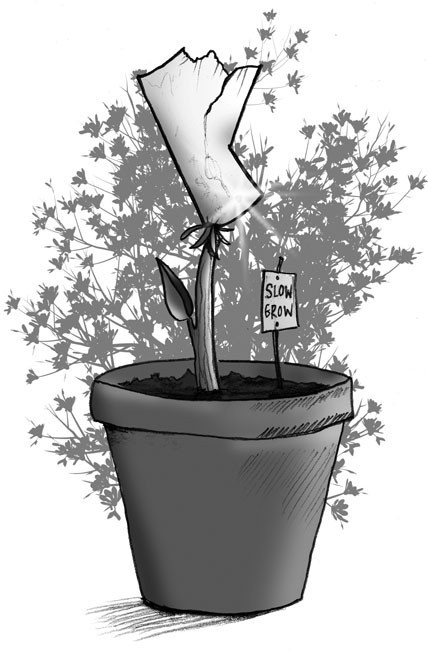Upwards and onwards
Slow growth is not an asset
In a time of economic loss and uncertainty around the world, a great deal of comfort has been taken here in Manitoba’s ostensibly stable economy. Owing to the province’s diverse set of natural resources and the nationalization of the largest of those – hydro-electricity – Manitoba has never really had one leading sector. Because of this, Manitoba has gone for years without experiencing sharp economic declines.
This is often seen as an advantage, particularly now, when once booming economies are in free-fall. But can Manitoba’s slow and steady formula win the race?
In 2008, close to 40 per cent of Manitoba’s revenues came from transfers from the federal government, and from other provinces. This transferred money has been put to use largely on large capital works projects such as the Floodway expansion and the construction of a new airport terminal in Winnipeg. It seems to work: the government can just turn on the taps on capital works spending whenever the economy demands it. Instant stability!
Often forgotten is that money has a source. Behind every dollar distributed in Manitoba is a free market economy that created that money. When that real economy suffers, it means less money pouring into Manitoba’s “stable” economy.
Just as an economy can not be propped up eternally by federal transfers, neither can a troubled city be revitalized simply on creativity, imagination and wishful thinking. An essay titled “Planning for possibility: the city becoming” by Molly Johnson and Richard Milgrom, both employed at the University of Manitoba’s City Planning department, offers a case for Winnipeg’s slow economic growth.
“The advantage of slow growth is that we should be able to take care of what we already have…” they write. “Slow change allows times to imagine what the city could become.”
The things best loved by urbanists and planners in Winnipeg’s physical environment – its buildings, streets, neighborhoods, parks and trees – all come from a period of intense boom and bust cycles between 1881 and 1914. In a period of only ten years (1900 to 1910), the city’s population more than tripled from 52,000 to 170,000.
Latter decades of slow growth, meanwhile, have rendered Winnipeg a largely ghettoized and misanthropic place. In spite of the best intentions of planners, and a great, heart-warming pool of imagination, art, holistic initiatives and community economic development, the population of the old City of Winnipeg has declined by almost a third since 1972. The luckiest traditional commercial thoroughfares have been pock-marked by strip malls, while the worst off have disappeared almost entirely. Portage and Main, the historical, geographic and economic heart of the city, has been barricaded to pedestrians for 30 years. Banal new suburbs mushroom at the city’s fringe, while the bounds of the impoverished inner city also sprawl outward.
A good idea is nothing but an idea without money. The desire and ability of individuals to make money in Winnipeg is the only thing that built soaring warehouses and commercial blocks in the Exchange District, or the beautiful houses that sit on tree-lined streets in the West End. It is also the only thing that will able to restore and reuse these into their second centuries.
For a city to be walkable and transit-oriented, it must be dense. In slow growth, density declines and small businesses go under. Automobile use in Winnipeg is not simply a lifestyle choice on the part of villainous suburbanites, but a matter of necessity. In most of Winnipeg’s formerly walkable, transit-oriented neighborhoods, living without a car is extremely laborious and demeaning. Amazingly, this is often more true the closer to downtown you live.
How can walkable neighborhoods exist where there is nothing to walk to? And how can there be anything practical to walk to without a market for it? Who will build these mixed-use apartments on parking lots downtown that planners like to imagine? Who will restore rotting heritage buildings, or revitalize troubled neighborhoods? In our current economic environment, the supply of re-usable urban space far exceeds the demand that slow growth creates. Proponents of slow growth should not protest the loss of heritage buildings, streetscapes, or whole neighborhoods, but instead recognize this as urban downsizing.
Under slow growth, the city is ruled by a dwindling cabal of Brahmins who frequently operate not by exchange and law, but by favour and graft. New wealth is seldom created, as it has become more commendable to receive than to produce. Nothing could be more exclusionary toward new arrivals to the city, desperate to rise up from poverty, than an economy that offers few new opportunities.
While capitalism is indeed cyclical and cannot make a guarantee of lasting growth (the way socialism can guarantee lasting stagnation), the boom and bust cycles are not always severe. And while two steps forward, one step back is never easy, wouldn’t it be preferable to not stepping forward at all?
Robert Galston blogs at riseandsprawl.blogspot.com.
Published in Volume 63, Number 16 of The Uniter (January 15, 2009)








